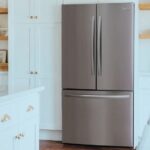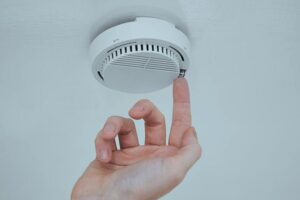There are quite a few reasons the freezer is cold, but the refrigerator is warm. This article will discuss five common causes, plus tips on fixing them.
The reason is most likely a faulty refrigerator component. Near the evaporator, a small fan and a motor work together to pull in the air above the condenser coils and circulate it inside the freezer and fridge. If this small fan malfunctions, you’ll end up with a warm refrigerator.
That’s just one possible cause. Let’s talk about the other possible causes in the next section of this article.
5 Possible Causes of a Warm Refrigerator

1. Frosted Over Evaporator Coils
Responsible for Cooling the Refrigerant
The evaporator coil is responsible for cooling the refrigerant, a heat-carrier chemical compound, for it to take in heat. If there’s a problem with your refrigerator’s defrost system, it could cause the evaporator coils to be completely frosted over.
Moisture Becomes Frozen
During a refrigerator’s refrigeration cycle, the moisture in the air becomes frozen and accumulates on the evaporator coils. Several times a day, your refrigerator’s defrost system turns on the defrost heater assembly for a couple of minutes to melt this frost or ice.
Effects of Damaged Defrost System
Ice will accumulate on the evaporator coils if defrost system components stop working properly. Eventually, the air cannot pass through to provide cooling, and the refrigerator becomes completely warm.
Possible Damaged Components
Diagnosing a faulty defrost system can be difficult because any of the following parts might be damaged:
- Defrost heater,
- Defrost timer or Defrost control, and
- Thermostat.
Use an Ohmmeter to Determine Which Component Is Damaged
To find out which one is faulty, you can use an ohmmeter electric device.
This measures the electrical resistance of a device. Electrical resistance refers to how difficult an electric current flows through an object or substance in its simplest definition:
- First, test your ohmmeter to know if it’s working properly. When the two probes touch each other, the reading on the meter should be zero.
- Before you use this device, be sure to turn off your refrigerator to avoid an electrical shock. Remove the back wall panel, then unplug the heater and thermostat. Depending on the model of your refrigerator, the defrost heater and thermostat are often connected in a series.
- Note: You can perform the test while the assembly is still installed. Just make sure you unplug the translucent plastic connector.
- Defrost heater: Place the ohmmeter’s red probe in the black wire slot. The black probe should be in the white or middle slot. If you don’t have continuity (zero reading or infinity), the heater is faulty and needs replacing.
- Thermostat: Place the ohmmeter’s black probe in the middle slot then the red probe in the light green or white wire. If there’s no continuity across the thermostat, it means it’s faulty and needs replacing.
- Defrost timer or defrost control: If both the defrost heater and thermostat are working properly, the defrost timer or defrost control needs replacing.
- As a temporary solution, you can take out the back panel of your freezer then pour hot water over the evaporator coils to melt the accumulated ice. If that gets your refrigerator running but fails again after a couple of days, you most likely need to replace one or more components of the defrost system.
2. Not Working Evaporator Fan
Mounted Behind the Freezer Wall
Above the evaporator coils, the evaporator fan is mounted behind the freezer wall. Its main job is to move cold air from the freezer and spread it all over the freezer and refrigerator. It comes on whenever the compressor cycles on.
Compressor Will Continue to Run
If the evaporator fan stops working, your refrigerator won’t be cool enough to prevent your food from spoiling. As an attempt to keep the compartments cool, the compressor would continue to run.
Reasons Why an Evaporator Stops Working
There are several reasons why an evaporator fan stops working:
- The fan is somehow blocked and stops circulating cold air into the cabin of your refrigerator if you put too much items inside.
- The motor, which spins the fan blades, is faulty.
- If the thermostat that reads the temperature in the refrigerator malfunctions, the fan stops working.
How to Fix
- One of the simplest things you could do is to avoid stuffing your freezer, so you won’t block the fan from spinning.
- Try spinning the blade of the fan by hand. If it doesn’t spin freely, or if you hear a chirping or squealing sound, replace it. The sound could indicate there’s something stuck in the fan blades or the motor is dying.
- Use a multimeter or ohmmeter to test the wiring of the fan’s motor for continuity. If the reading shows infinity, you need to replace the motor.
- If the motor is working fine, the thermostat might be the problem. Again, test the two wires coming into the thermostat for electrical resistance using the multimeter or ohmmeter. If you get infinity readings, take out the thermostat and replace it with a new one.
3. Failing Thermistor

A Thermistor Is a Type of Temperature Sensor
A thermistor is different from a thermostat. A thermistor is an electrical device made from metallic oxide and then enclosed with glass or epoxy. It takes the form of a bead, disk, or cylinder.
A thermistor is a type of temperature sensor. Together with fresh food thermistors, it’s supposed to transmit temperature reading from your refrigerator to its control board, the “brain” of a refrigerator.
Help the Control Board Determine When to Activate Components
The temperature reading will help the control board determine when to activate or deactivate specific components of your refrigerator, including the compressor, fans, and damper.
Refrigerator Cannot Maintain the Set Temperature
If one of the thermistors fails, your refrigerator won’t maintain your set temperature. This will cause items in your refrigerator to become frozen or spoiled because it’s too cold or too warm.
Causes of a Failing Thermistor
What causes a thermistor to stop working properly? The good news is it rarely happens. If it does fail, it could be because of two things:
- It could be due to a break in the electrical wires between the main control board and thermistor. As a result, the current can’t flow from the power source to the other.
- Normal wear and tear as they age.
How to Diagnose a Failing Thermistor
You can’t tell a failing thermistor through visual inspection alone. Most of the time, the problem results from internal chemical deterioration in resistance over some time.
Use your ohmmeter or multimeter to determine if it’s time to replace your refrigerator’s thermistor. If the ohm reading is less than or more than 11 K ohms at room temperature, then your thermistor needs replacing.
Again, why is the fridge not cold, but the freezer is working? If the fridge is not working, but the freezer is, there might be a problem with the fridge’s components. Check the fan and motor near the evaporator since it draws air and circulates it to the fridge.
4. Malfunctioning Air Damper Control
Lets Cold Air Flow from the Freezer to the Fresh Food Compartment
The air damper control is a small flap controlled by a thermostat, which decides when it closes and opens to let cold air flow from the freezer to the fresh food compartment. It’s located on top of the back wall.
How to Check If Air Damper Control Has Issue
If your freezer is cold, but the fresh food compartments and drawers are warm, the air damper control could be closed, damaged, or stuck. Fortunately, it’s generally easy to check if there’s an issue with your refrigerator’s damper—place your hand in front of the vent.
Is there cold air coming out and flowing to the fresh food section? If there’s none or there’s too much or too little cold air, the damper control might be malfunctioning.
How to Fix
Suppose the vent protecting the damper flap is removable; take it out and manually move the damper. If that doesn’t work, get a refrigeration technician to repair it.
Sometimes, other components of your refrigerator’s cooling system might be affecting the operation of the air damper control. Or in other models of refrigerators, the air damper control is connected to other components of the electrical system, such as the thermostat and timer.
This makes it harder to replace the damper, especially if the external thermostat malfunctions. In this case, it’s best to hire a refrigeration technician to diagnose and fix the problem.
5. Motherboard
Manages All the Refrigerator’s Inner Workings
The motherboard, also known as the control board or mainboard, is the brain of your refrigerator. It controls practically everything, including:
- Running time of the compressor,
- Temperature settings,
- Collecting inputs from various sensors, and so on.
Since, in theory, it manages all the inner workings of your refrigerator, the motherboard can cause any feature or component that stops working correctly.
Susceptible to Power Outages
Like a computer’s motherboard, it’s also susceptible to power outages, spikes, and surges. Fortunately, it rarely breaks down.
Check Other Components for Damage
So, before replacing it, check if other components are working as they should, such as:
- Compressor motor,
- Ice maker motor,
- Thermostat,
- Water inlet valve,
- Evaporator fan motor, etc.
Why Is My LG Freezer Not Freezing?
Frigidaire Refrigerator Not Cooling
How to Determine If the Fridge’s Motherboard and Other Components Are Working Properly?

Follow these steps to determine if your motherboard and other components of your refrigerator are working properly:
1. Have the Multimeter Ready
You’ll need a multimeter to measure continuity and voltage for these diagnostic tests.
2. Remove the Access Panel
Remove the access panel to its motherboard or control board. Your refrigerator should be plugged into an electrical outlet at this point. Be careful not to touch anything on the motherboard because there’s live voltage.
3. Test the Voltage Flowing Into the Motherboard
Turn the knob of your multimeter to AC voltage, which is indicated as a capital ‘V’ with a wavy line over it.
Test the voltage flowing into the motherboard by placing the black test lead on the orange wire and the red test lead on the blue connector, which usually has a brown wire coming into it. If the reading is 120 volts, it means you have a working motherboard.
4. Open the Fridge’s Door for Three Minutes
Your next step is to open the door of your refrigerator or freezer for three minutes. You’ll put the motherboard into linear protection mode by opening any of these doors. This mode will run the evaporator fan and condenser fan, which you’ll test later.
5. Locate the J2 Connector
Locate the J2 connector. It’s easy to spot because it’s properly marked on the control board. As you can see, the third pin contains the white wire. The fourth wire has the yellow-and-black wire, while you can find the solid yellow wire next to it. The red wire is in the eight-pin.
6. Turn on the Multimeter
Turn on your multimeter and set it to DC volts. Place the black test lead on the white wire (third pin) and the red test lead on the red wire (eight-pin). If the motherboard is functioning correctly, it should be supplying 12 to 14 volts to the fan motors.
7. Check the Voltage from the Motherboard to the Fan Motors
In the next test, you’ll check the voltage from the motherboard to the fan motors. Again, take your black test lead and put it on the white wire, then the red test lead on the red wire. If the reading is all over the place (not within 12 to 14 volts), it’s not sending the correct voltage to the fan motors.
8. Inspect the Evaporator Fan Motor
Place the black test lead on the white wire and the red test lead on the yellow-and-black wire (fourth pin). You have a bad motherboard if the reading isn’t between 12 and 14 volts.
9. Test the Condenser Fan Motor
Place the black test lead on the white wire and the red test lead on the yellow wire (fifth pin). Again, the reading should be between 12 and 14 volts.
Now, test for failed evaporator fan and condenser fan. Usually, the evaporator fan is why the motherboard malfunctions because of moisture infiltration.
10. Unplug the Refrigerator
Be sure to unplug your refrigerator and remove the J2 connector from the motherboard. Don’t pull the J2 connector. Just pull it from the sides to prevent damage.
11. Set Multimeter to Ohms
Set your multimeter to ohms, indicated by the ohm symbol (Ω). Place the black test lead on the white wire and the red test lead on the red wire. The reading on your multimeter should be between 1.5 and 3 ohms. There’s a problem with the fan circuit if it’s way too low.
12. Inspect the Resistors on the Motherboard
Be sure to inspect the two resistors on the motherboard, too. The left resistor is for the evaporator fan motor, and the resistor for the condenser fan motor is the one on the right. If one or both are black or brown, it means there’s a failure of the actual fan motor. As a result, your motherboard becomes damaged.
Conclusion – Why the Fridge Is Not Cold but the Freezer Is?
There are good sources online to help you diagnose and fix refrigerator cooling problems. But I still highly recommend you get a professional to do the job—or risk spending more money on repairing an old appliance and compromising your safety. Better yet, why not upgrade to the latest refrigerator model from a trusted brand?
Read next:
9 Possible Fixes to a Whirlpool Refrigerator Not Cooling or Freezing

![Freezer Not Working but Fridge Is [Causes and How to Fix] freezer not working but fridge is](https://homecarezen.com/wp-content/uploads/2021/06/freezer-not-working-but-fridge-is-150x150.jpg)


![Hot Water Not Working but Cold Is [How to Fix] Hot Water Not Working but Cold Is](https://homecarezen.com/wp-content/uploads/2021/10/hot-water-not-working-but-cold-is-150x150.jpg)
![Hot Water Pressure Low but Cold Fine [Causes and How to Fix] Hot Water Pressure Low but Cold Fine](https://homecarezen.com/wp-content/uploads/2021/12/hot-water-pressure-low-but-cold-fine-150x150.jpg)



![Read more about the article Electric Dryer Not Heating [Causes and How to Fix]](https://homecarezen.com/wp-content/uploads/2021/11/electric-dryer-not-heating-300x200.jpg)